Imagine a plant that climbs and fills your home with life. The creeping fig vine does just that. It turns empty walls into living art or softens stark corners.
For those who love greenery but worry about overwatering or sunlight, this plant is a game-changer.
The creeping fig vine has tiny heart-shaped leaves and trailing stems. It adapts to any style, from minimalist lofts to cozy family rooms. It’s not just a plant; it’s a versatile decorative vine that brings life to spaces and filters the air.
Perfect for beginners and experts alike, it shows that beauty and ease can go together.
Key Takeaways
- Creeping fig vine thrives in low to bright indirect light, making it an ideal indoor vine for diverse homes.
- Its trailing growth habit makes it a standout decorative vine for shelves, pots, or hanging baskets.
- Requires minimal care yet adds instant style to modern or traditional interiors.
- Purifies air while demanding little water, ideal for busy lifestyles.
- Perfect for renters or homeowners seeking adaptable greenery that fits any space.
What is Creeping Fig Vine?
The creeping fig vine (Ficus pumila) is a fast-growing evergreen from East Asia. It thrives indoors and outdoors, using special roots to stick to surfaces. Its small leaves and trailing growth make it great for vertical gardens.
Botanical Characteristics
This plant has tiny, heart-shaped leaves that are 0.5–1 inch long. Its leaves start as bronze and turn deep green as they grow. The stems are thin and branch out a lot, creating a mat-like structure. It belongs to the Moraceae family, like common fig trees.
Growth Habits
It climbs up walls, fences, and containers using aerial roots. It grows 3–6 inches every month. Young plants trail, but older ones get thicker stems. Its fast growth is ideal for quick projects.
Common Varieties
- Quercifolia: Leaves with oak-like lobes add texture to hanging baskets.
- Variegata: Golden-yellow leaf edges contrast with green for vibrant displays.
- Minima: Dwarf form with miniature leaves, suited for small spaces.
Why Choose Creeping Fig Vine for Your Home?
The creeping fig vine is both beautiful and practical, making it perfect for modern homes. It’s a decorative vine that brings elegance to any space. Plus, it’s an indoor vine that does well in many environments.
Its ability to grow as a wall cover plant turns blank walls into stunning pieces of art. It combines nature with modern design beautifully.
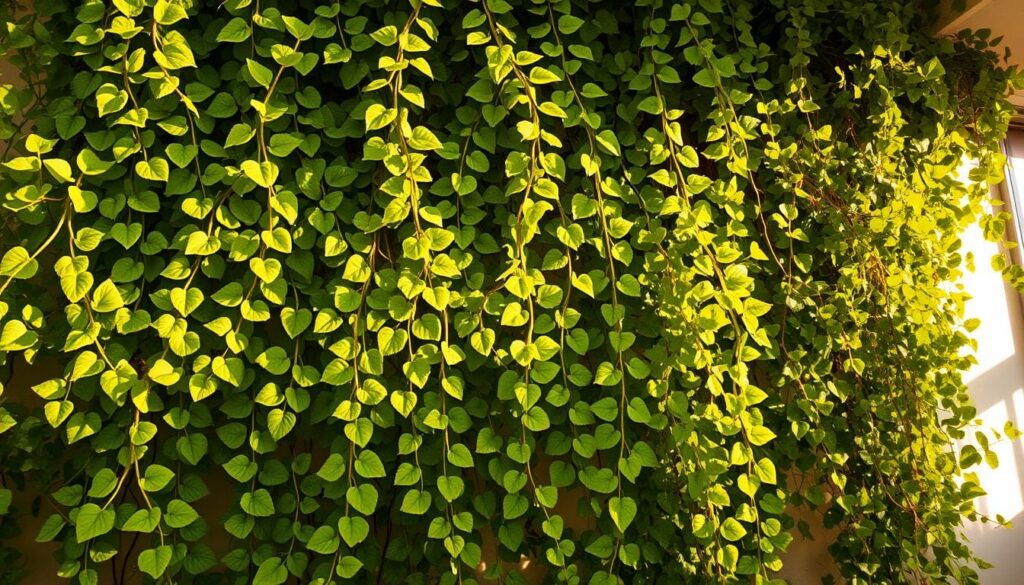
Aesthetic Appeal
Trailing varieties can soften sharp corners or flow beautifully from shelves. They create eye-catching spots. As a wall cover plant, it creates lush green screens that hide flaws or add texture to walls.
Some popular ways to display it include:
- Trailing from hanging planters in sunlit windows
- Climbing moss-covered frames for vertical greenery
- Accenting bookshelves or mantles as an indoor vine
Air Purification Qualities
Studies show this plant can clean indoor air. NASA research found it filters out harmful chemicals like formaldehyde and benzene. As an decorative vine, it quietly improves air quality while making your space look better.
“The creeping fig’s foliage actively absorbs pollutants, making it a natural air purifier.” – NASA Clean Air Study
This vine is great for both looks and health. It’s a stylish wall cover plant and a natural air purifier. It fits well in any home, bringing beauty and health benefits.
Ideal Growing Conditions for Creeping Fig Vine
Creating the right environment is essential for a creeping fig care. This indoor vine does well indoors but excels with certain light, soil, and climate conditions.
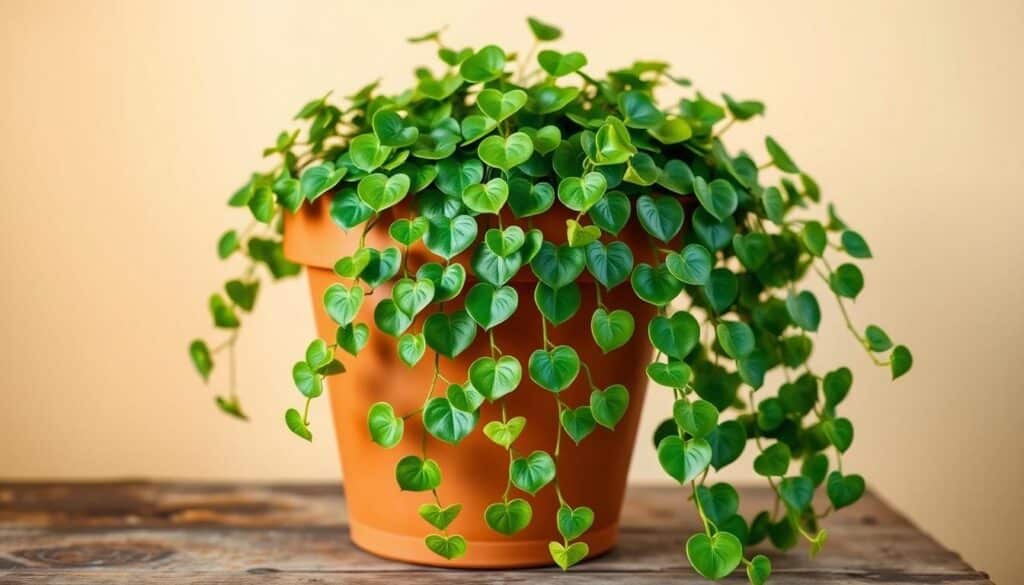
Light Requirements
Bright indirect light is best. Position it near east- or north-facing windows to prevent burning. Rotate the pot every week for balanced growth. It can survive in low light, but it grows slower.
- Direct sun can burn leaves; use sheer curtains if light is intense.
- South-facing windows need shade cloth in summer.
Soil Preferences
Soil that drains well is key to avoid root rot. Mix peat moss, perlite, and potting soil. Heavy soils that hold moisture are a no-go.
- Check soil moisture before watering—dry topsoil means it’s time.
- Add coarse sand to improve drainage in standard mixes.
Temperature and Humidity
Keep the temperature between 65–85°F (18–29°C). Mist the leaves weekly or use a pebble tray to increase humidity. In dry areas, group plants together to create a humid spot.
Temperatures below 55°F (13°C) harm the leaves. For ongoing problems, check disease signs to catch issues early.
Planting Creeping Fig Vine
Starting a creeping fig vine needs careful timing and technique. Whether indoors or outdoors, planting right ensures it grows roots fast. Follow these steps for a thriving climbing plant.
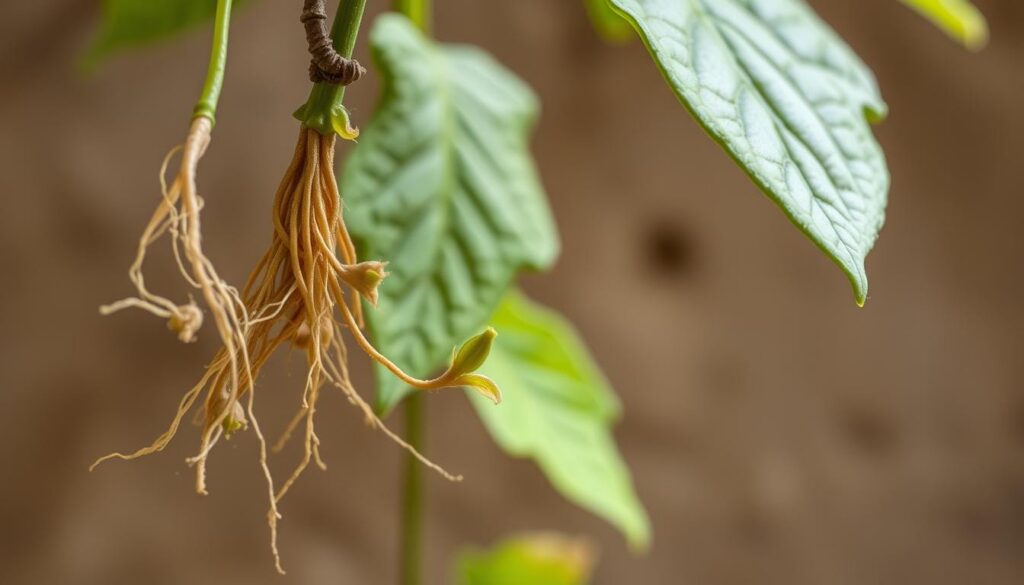
Best Time for Planting
Plant outdoors in spring or early summer when it’s 65–75°F. Indoor growers can plant anytime but match it with the plant’s growth phase. Stay away from frost or extreme heat to protect young roots.
Propagation Methods
There are three ways to grow more creeping fig vines:
- Stem Cuttings
Take 4–6″ cuttings with 2–3 nodes. Trim leaves from the lower half. Dip the cut end in rooting hormone and plant in moist potting mix. Keep soil damp until roots form in 4–6 weeks. - Air Layering
Wrap a healthy stem node in damp sphagnum moss. Cover with plastic wrap and secure with twine. After roots form (6–8 weeks), cut the new plant from the parent and pot separately. - Division
Divide the root ball during repotting. Ensure each section has visible roots and stems. Plant divisions in fresh soil and water thoroughly.
Use clean tools to prevent damage. All methods need indirect light and consistent moisture. Once rooted, the fast-growing vine will climb rapidly when cared for properly.
Care Guidelines for Creeping Fig Vine
To keep your creeping fig vine thriving, focus on watering and nutrients. This easy-care vine does well indoors but needs regular care. Follow these tips to ensure your indoor vine stays healthy and vibrant.
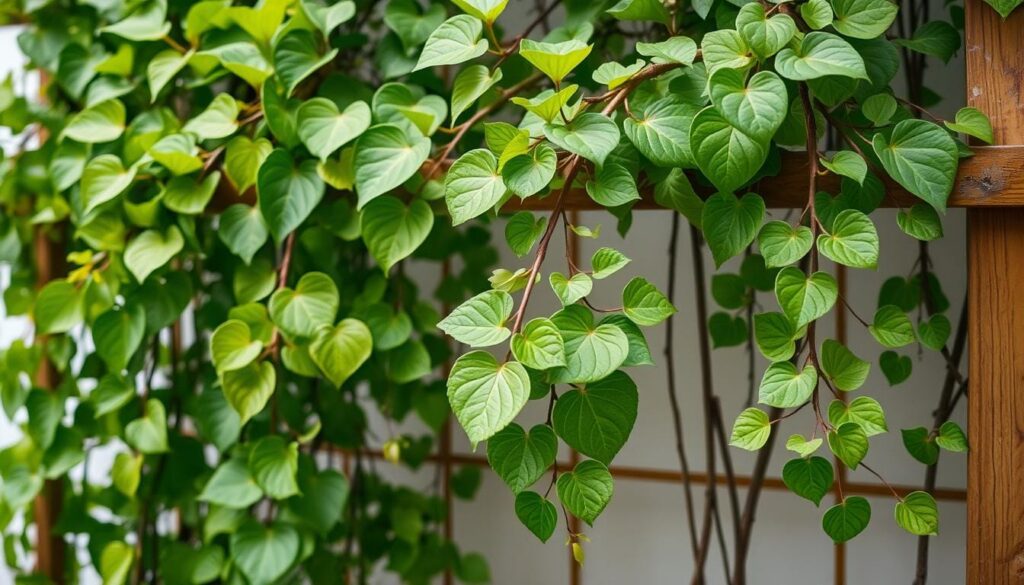
Watering Practices
Adjust your watering based on the season and pot size:
- Water when the soil feels dry 1-2 inches deep.
- Make sure not to waterlog it—use pots with holes for drainage.
- In winter, water less; in summer, more.
“Overwatering is the top mistake for new growers,” warns the National Gardening Association.
Fertilization Tips
Feed your creeping fig care plant when it’s actively growing. Use:
| Type | Application | Frequency |
|---|---|---|
| 10-10-10 liquid fertilizer | Half-strength diluted solution | Every 4-6 weeks |
| Slow-release pellets | 1 tsp per 2L soil | Once every 3 months |
Stop feeding in winter. If leaves turn yellow, it might mean you need more nitrogen. Adjust your fertilizer as needed.
Common Pests and Diseases
Creeping fig care for indoor vines requires watching out for threats. This hardy vine can face pests and diseases. Regular checks help find problems early.
Identifying Common Issues
| Pest/Disease | Symptoms | Solutions |
|---|---|---|
| Spider Mites | Yellow spots, fine webs | Rinse leaves; neem oil sprays |
| Scale Insects | Waxy bumps, sticky residue | Alcohol wipes; insecticidal soap |
| Mealybugs | Cotton-like clusters | Isolate plant; horticultural oil |
| Root Rot | Yellow leaves, mushy stems | Trim rotted roots; repot with fresh soil |
| Powdery Mildew | White powder on leaves | Improve airflow; fungicide spray |
Prevention Strategies
- Inspect new plants before introducing them to your collection
- Water sparingly to avoid root rot
- Use neem oil or insecticidal soap monthly as a preventive measure
For indoor vines, keep 6-8 inches between plants for better air flow. Check your plants every quarter to catch issues early. Organic methods like sticky traps work well with chemical treatments. Always keep sick plants away from others. Following these steps keeps your vine healthy and vibrant.
Pruning and Maintenance
Regular pruning keeps the creeping fig vine healthy and looking good. It’s important to prune at the right time and in the right way. This helps control the fast-growing vine without hurting its growth.
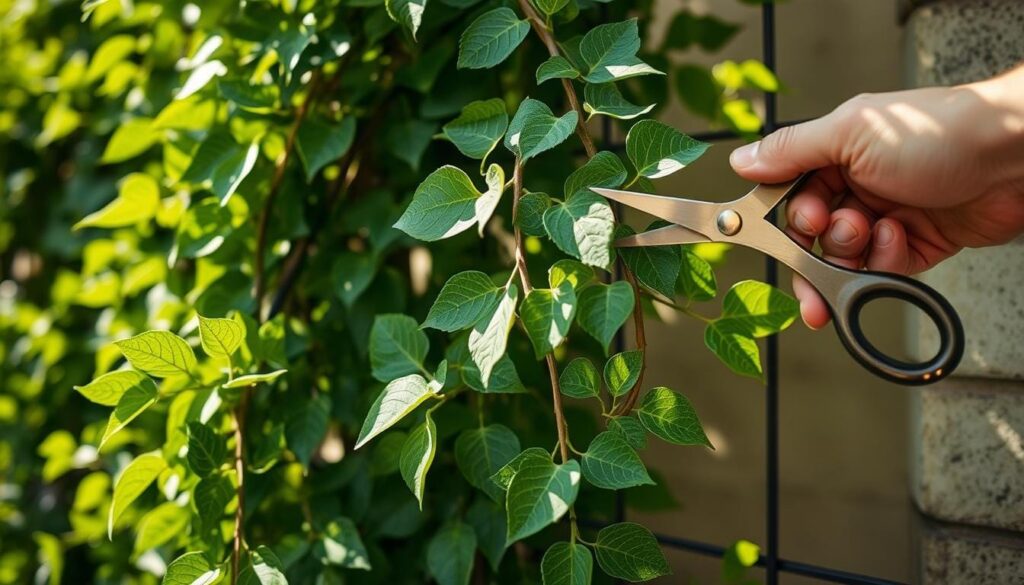
When to Prune
Prune in the active spring or early summer. Don’t prune in winter when the plant heals slowly. Check for overgrown stems or tangled branches every month to fix problems early. Pruning at the right time helps the plant stay healthy.
Techniques for Pruning
Use sharp, clean shears to cut back stems at 45-degree angles. Cut just above leaf nodes. To keep it small, remove up to one-third of growth each year. For a decorative vine look, shape it into cascading forms or train it along supports. Here’s how:
- Pinch tips to encourage bushier growth.
- Remove dead or diseased sections immediately.
- Wear gloves when handling sap to avoid skin irritation.
To keep hanging baskets or topiaries looking even, trim uneven areas. Regular light pruning keeps the plant healthy and looking great.
Using Creeping Fig Vine Indoors
Make any room special with the creeping fig vine. It’s a great indoor vine for home use. Its long stems and thick leaves make it perfect as a wall cover plant or a stylish decor piece.
Best Indoor Locations
Choose bright, indirect light for the best growth. Bathrooms are great because they’re humid. Living rooms with soft sunlight work well too. But, keep it away from drafts and heat vents. The ideal temperature is 65–75°F (18–24°C).
Creative Display Ideas
- Hanging Displays: Use macramé hangers or wire baskets to let vines cascade.
- Living Walls: Train the wall cover plant on moss-covered frames for a green accent.
- Desk Accents: Place in terrariums or tiered plant stands for compact spaces.
Pair it with plants that love humidity, like ferns. This is a tip from ChikusGarden. Trim long stems to keep it looking neat. Also, turn the pot every week to get even light. This indoor vine fits well on shelves, bookcases, or trellises, bringing nature indoors.
Using Creeping Fig Vine Outdoors
Creeping fig vines do well outdoors in USDA zones 8-11. They are a great fast-growing vine for outdoor spots. In warmer places, they can change how we see outdoor areas. Experts at Chikus Garden suggest pairing them with native plants for better balance.
Here are some garden design ideas:
- Use them as ground cover under trees for shaded spots
- Make privacy screens along property lines
- Soften the look of patios or retaining walls
“When picking plants to go with them, choose ones that need the same amount of water,” says the Chikus Garden team.
Trellis and wall options need careful planning. Choose strong structures like:
- Metal trellises for vertical growth
- Wire mesh panels to guide their climb
- Stone walls for their adhesive roots
Check surfaces yearly to avoid damage from roots. In colder areas, treat them as annuals and move them indoors before frost.
Keep them in check with seasonal pruning. This helps them stay useful as a wall cover plant. Check local gardening guides for tips on caring for them in your area.
Environmental Benefits of Creeping Fig Vine
The creeping fig vine (Ficus pumila) is more than just a pretty plant. It’s a climbing plant that helps keep landscapes stable and ecosystems healthy.
Erosion Control
This wall cover plant creates a thick layer of roots. These roots hold soil together, reducing soil loss by 85% on slopes. It’s been used in places like Florida and California to stop coastal erosion during storms.
“Ficus pumila’s root network outperforms synthetic erosion barriers in long-term soil retention.” – Coastal Erosion Study 2023
| Benefit | Erosion Control | Wildlife Support |
|---|---|---|
| Soil retention | 85% reduction in runoff | Shelter for 20+ insect species |
| Cost savings | $400/yard vs $1,200 for rock barriers | Bird nesting sites increase by 30% |
Biodiversity Support
- Leathery leaves provide year-round cover for pollinators
- Fall fruit clusters feed migratory birds
- Trunk-climbing stems create microhabitats for beneficial insects
But, it’s important to prune it regularly in warm climates. This keeps it from taking over and losing its environmental benefits.
Troubleshooting Common Issues
Even the easiest-care vine like ficus pumila can face challenges. Recognizing signs early ensures healthy growth. Let’s address two frequent concerns: yellowing leaves and slowed progress.
Yellowing Leaves
Yellow leaves often signal stress. Common causes and fixes:
- Overwatering: Let soil dry 1-2 inches deep before watering again.
- Poor light: Move to bright indirect light—east or north-facing windows work best.
- Pest issues: Wipe leaves with neem oil for scale insects or mealybugs.
Slow Growth
Stunted growth may stem from environmental stress. Check these factors:
- Low light: Provide 4-6 hours of filtered sunlight daily.
- Rootbound roots: Repot into a container 2 inches wider every 2 years.
- Cold drafts: Maintain 65-75°F (18-24°C) temperatures year-round.
“With proper creeping fig care, most issues resolve within weeks,” says horticulturist Maria Green. “Adjust one factor at a time to track improvements.”
Regular inspections and minor adjustments keep this resilient easy-care vine thriving. Always prioritize drainage, light balance, and seasonal adjustments for optimal growth.
Conclusion: Embracing the Creeping Fig Vine
The creeping fig vine is both stylish and easy to care for. It’s perfect for both indoor and outdoor spaces. With the right care, it thrives in various environments, adding greenery to any spot.
Final Thoughts on Care and Aesthetics
Light, water, and pruning are key to the creeping fig vine’s success. It needs bright indirect light, as our guide to light requirements shows. It also needs well-draining soil and consistent moisture to stay healthy.
As a climbing plant, it looks great on walls or hanging baskets. Regular pruning keeps it looking good and healthy. This boosts its beauty and longevity.
Encouragement for New Growers
New growers will find the creeping fig vine easy to care for. It’s forgiving, making it perfect for beginners. With a little patience and attention to light and water, it can transform any space.
Start small and watch it grow. It’s a great addition to both indoor and outdoor decor.

